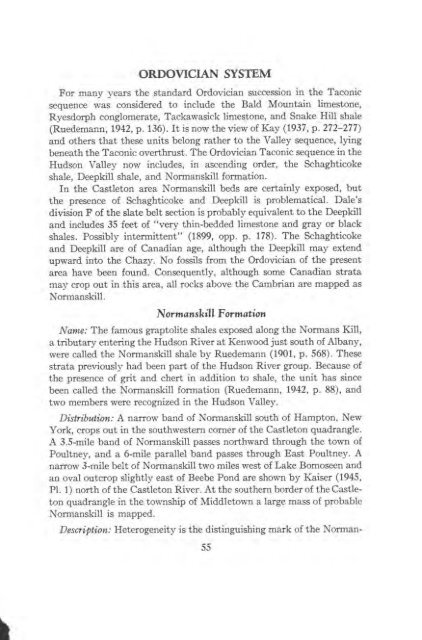STRATIGRAPHY AND STRUCTURE CASTLETON AREA VERMONT
STRATIGRAPHY AND STRUCTURE CASTLETON AREA VERMONT
STRATIGRAPHY AND STRUCTURE CASTLETON AREA VERMONT
Create successful ePaper yourself
Turn your PDF publications into a flip-book with our unique Google optimized e-Paper software.
ORDOVICIAN SYSTEM<br />
For many years the standard Ordovician succession in the Taconic<br />
sequence was considered to include the Bald Mountain limestone,<br />
Ryesdorph conglomerate, Tackawasick limestone, and Snake Hill shale<br />
(Ruedemann, 1942, P. 136). It is now the view of Kay (1937, P. 272-277)<br />
and others that these units belong rather to the Valley sequence, lying<br />
beneath the Taconic overthnist. The Ordovician Taconic sequence in the<br />
Hudson Valley now includes, in ascending order, the Schaghticoke<br />
shale, Deepkill shale, and Normanskill formation.<br />
In the Castleton area Normanskill beds are certainly exposed, but<br />
the presence of Schaghticoke and Deepkill is problematical. Dale's<br />
division F of the slate belt section is probably equivalent to the Deepkill<br />
and includes 35 feet of "very thin-bedded limestone and gray or black<br />
shales. Possibly intermittent" (1899, opp. p. 178). The Schaghticoke<br />
and Deepkill are of Canadian age, although the Deepkill may extend<br />
upward into the Chazy. No fossils from the Ordovician of the present<br />
area have been found. Consequently, although some Canadian strata<br />
may crop out in this area, all rocks above the Cambrian are mapped as<br />
Normanskill.<br />
NormansJU Formation<br />
Name: The famous graptolite shales exposed along the Normans Kill,<br />
a tributary entering the Hudson River at Kenwood just south of Albany,<br />
were called the Normanskill shale by Ruedemann (1901, p. 568). These<br />
strata previously had been part of the Hudson River group. Because of<br />
the presence of grit and chert in addition to shale, the unit has since<br />
been called the Normanskill formation (Ruedemann, 1942, p. 88), and<br />
two members were recognized in the Hudson Valley.<br />
Distribution: A narrow band of Normanskill south of Hampton, New<br />
York, crops out in the southwestern corner of the Castleton quadrangle.<br />
A 3.5-mile band of Normanskill passes northward through the town of<br />
Poultney, and a 6-mile parallel band passes through East Poultney. A<br />
narrow 3-mile belt of Normanskill two miles west of Lake Bomoseen and<br />
an oval outcrop slightly east of Beebe Pond are shown by Kaiser (1945,<br />
P1. 1) north of the Castleton River. At the southern border of the Castleton<br />
quadrangle in the township of Middletown a large mass of probable<br />
Normanskill is mapped.<br />
Description: Heterogeneity is the distinguishing mark of the Norman-<br />
55













